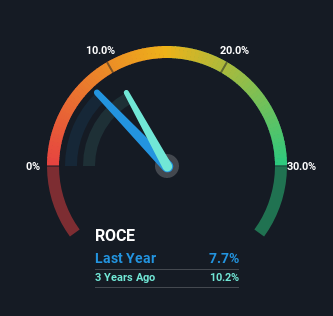Poddar Pigments (NSE:PODDARMENT) Might Be Having Difficulty Using Its Capital Effectively
If we want to find a potential multi-bagger, often there are underlying trends that can provide clues. Typically, we'll want to notice a trend of growing return on capital employed (ROCE) and alongside that, an expanding base of capital employed. Basically this means that a company has profitable initiatives that it can continue to reinvest in, which is a trait of a compounding machine. Having said that, from a first glance at Poddar Pigments (NSE:PODDARMENT) we aren't jumping out of our chairs at how returns are trending, but let's have a deeper look.
What Is Return On Capital Employed (ROCE)?
For those who don't know, ROCE is a measure of a company's yearly pre-tax profit (its return), relative to the capital employed in the business. Analysts use this formula to calculate it for Poddar Pigments:
Return on Capital Employed = Earnings Before Interest and Tax (EBIT) ÷ (Total Assets - Current Liabilities)
0.077 = ₹253m ÷ (₹3.5b - ₹252m) (Based on the trailing twelve months to June 2022).
Thus, Poddar Pigments has an ROCE of 7.7%. Ultimately, that's a low return and it under-performs the Chemicals industry average of 17%.
Check out our latest analysis for Poddar Pigments

Historical performance is a great place to start when researching a stock so above you can see the gauge for Poddar Pigments' ROCE against it's prior returns. If you want to delve into the historical earnings, revenue and cash flow of Poddar Pigments, check out these free graphs here.
How Are Returns Trending?
When we looked at the ROCE trend at Poddar Pigments, we didn't gain much confidence. Over the last five years, returns on capital have decreased to 7.7% from 14% five years ago. However, given capital employed and revenue have both increased it appears that the business is currently pursuing growth, at the consequence of short term returns. And if the increased capital generates additional returns, the business, and thus shareholders, will benefit in the long run.
In Conclusion...
Even though returns on capital have fallen in the short term, we find it promising that revenue and capital employed have both increased for Poddar Pigments. However, total returns to shareholders over the last five years have been flat, which could indicate these growth trends potentially aren't accounted for yet by investors. So we think it'd be worthwhile to look further into this stock given the trends look encouraging.
On a separate note, we've found 2 warning signs for Poddar Pigments you'll probably want to know about.
While Poddar Pigments may not currently earn the highest returns, we've compiled a list of companies that currently earn more than 25% return on equity. Check out this free list here.
New: Manage All Your Stock Portfolios in One Place
We've created the ultimate portfolio companion for stock investors, and it's free.
• Connect an unlimited number of Portfolios and see your total in one currency
• Be alerted to new Warning Signs or Risks via email or mobile
• Track the Fair Value of your stocks
Have feedback on this article? Concerned about the content? Get in touch with us directly. Alternatively, email editorial-team (at) simplywallst.com.
This article by Simply Wall St is general in nature. We provide commentary based on historical data and analyst forecasts only using an unbiased methodology and our articles are not intended to be financial advice. It does not constitute a recommendation to buy or sell any stock, and does not take account of your objectives, or your financial situation. We aim to bring you long-term focused analysis driven by fundamental data. Note that our analysis may not factor in the latest price-sensitive company announcements or qualitative material. Simply Wall St has no position in any stocks mentioned.
About NSEI:PODDARMENT
Poddar Pigments
Manufactures and sells color and additive masterbatches for dope dyeing of man-made fibers and various plastic applications primarily in India.
Excellent balance sheet average dividend payer.
Similar Companies
Market Insights
Community Narratives



